This story from the Australian Aviation archives comes from October 2011, when Thierry Moïsse wrote about aviation’s role in broadcasting the Tour de France.

Aviation played a critical role in beaming to the world the images of Australian Cadel Evans’s history making victory at the 2011 Tour de France.
Images of Evans’ fighting victory in the iconic cycling stage race around France, the world’s third biggest sporting event behind the football World Cup and the summer Olympic Games, were beamed live into Australian loungerooms over three weeks in July by SBS TV, one of no fewer than 100 TV stations worldwide to broadcast the race pictures provided by the cameras of France Télévisions.
Coverage of the first Australian victory at Le Tour would not have been possible without an impressive airborne armada.
This Tour de France “squadron” comprises two very different parts – filming and relaying TV footage and radio signals involves four helicopters and six fixed-wing aircraft, while a further five helicopters and two corporate jets are assigned to VIP transportation. Then there are often further helicopters and aircraft involved, such as police, rescue and miscellaneous transportation.
A tour before the Tour
While the basic race route for the 2011 Tour de France – designed by race organiser ASO’s Christian Prudhomme and Jean François Pescheux – was revealed in October 2010, detailed preparation for filming the race doesn’t begin until January 2011 once route details for each stage are defined in detail and less prone to change. It is then that Jean Maurice Ooghe takes his car, his 1/100,000 maps, his GPS and his dictaphone, and along with an assistant, starts reconnoitring the race route.
Ooghe is France Télévisions’ director in charge of the live broadcast of the Tour de France. Over seven weeks, he not only follows every centimetre of the race route, but also locates all landmarks – such as natural features and historic buildings within 25 or 30km of the race route. The result is a 226-page roadbook describing the route in detail – roundabouts, villages, crossings, quality of the roads, powerlines – and dividing up each stage into sequences for filming by motorbike (moto) or helicopter cameras.
To give an example of the detail of the roadbook, for the beginning of the Pau-Lourdes stage it read: “until Artiax (for 6km), road descending and winding; at the bottom of the descent, roundabout 90° left then winding crossing through the village; 300m after the roundabout after the village powerlines across the road”. Every item is located by the distance to go before the finish line.
Ooghe also notes the GPS coordinates of all interesting points, ie “this castle to be filmed is located at this place, in this field there will be a display by farmers”. He takes photos of landmarks so that the helicopter pilots and motorbike riders can identify them more easily, allowing them to film sequences just as Ooghe planned.
Besides reconnoitring the route by road in May, Ooghe also uses a helicopters to fly over certain features of the race, such as passes that are to be used for the first time. He can also talk to the pilot about obstacles such as powerlines, and consider what will and won’t be possible to request the camera helicopters to do from a safety perspective.

Onboard cameras
Two helicopters – H1 and H2, both operated by Helicopters de France (HdF) – are dedicated to filming the race from the air, in addition to various fixed cameras positioned near key points – such as intermediate sprints, mountain passes and finishing lines – and five cameramen who ride on the back of motorbikes (motos).
H2 is a twin engine AS355 Squirrel able, under French regulations, to overfly population centres at low height. It carries only one, long focal lens Cineflex gyro-stabilised camera – which can zoom up to 42 times magnification – mounted in an external pod. It is operated by a cameraman seated in H2’s rear cabin via a control panel, with a screen to his left showing the camera’s images. On the front seat, another screen enables the pilot to see the camera’s images. H2 is usually tasked with filming the head of the race, flying low, and shooting over population centres, the end of the stage and the sprints from overhead, for example.
H1 is sometimes a twin engined AS355 Squirrel, sometimes a more powerful AS350B3, depending on the terrain to be overflown. H1 carries two cameras, a powerful zoom, the same as on H2, and a wide angle camera used for landscapes. If there is a breakaway from the peloton (the main group of riders in the race), H1 shoots the peloton while H2 follows the race leaders. H1 is also responsible for most of the stunning landscape sequences of the French countryside which epitomise the Tour de France coverage. The director and pilots call these sequences (in English) “beauties”. Consequently, H1 often has to leave the race to go ahead and shoot a cliff, a castle or a village. On occasion, H2 also shoots “beauties” if needed.
Another consideration for Ooghe is taking into account refuelling the helicopters, and planning which machine is airborne at what moment.
Typically, H2 covers the beginning of the broadcast, while H1 takes off directly for a refuelling zone, located at a mid-point along the stage. Once its tanks are filled, at a time chosen by Ooghe, H1 takes off and relieves H2, allowing H2 to briefly land to refuel, a process that takes about 10 to 15 minutes. The two helicopters are then airborne for the crucial second half of the stage.
These landing zones didn’t necessarily have to be located right next to the race route of the race. Ideally a field is selected two or three minutes flight time away, chosen for easy access for the fuel trucks.
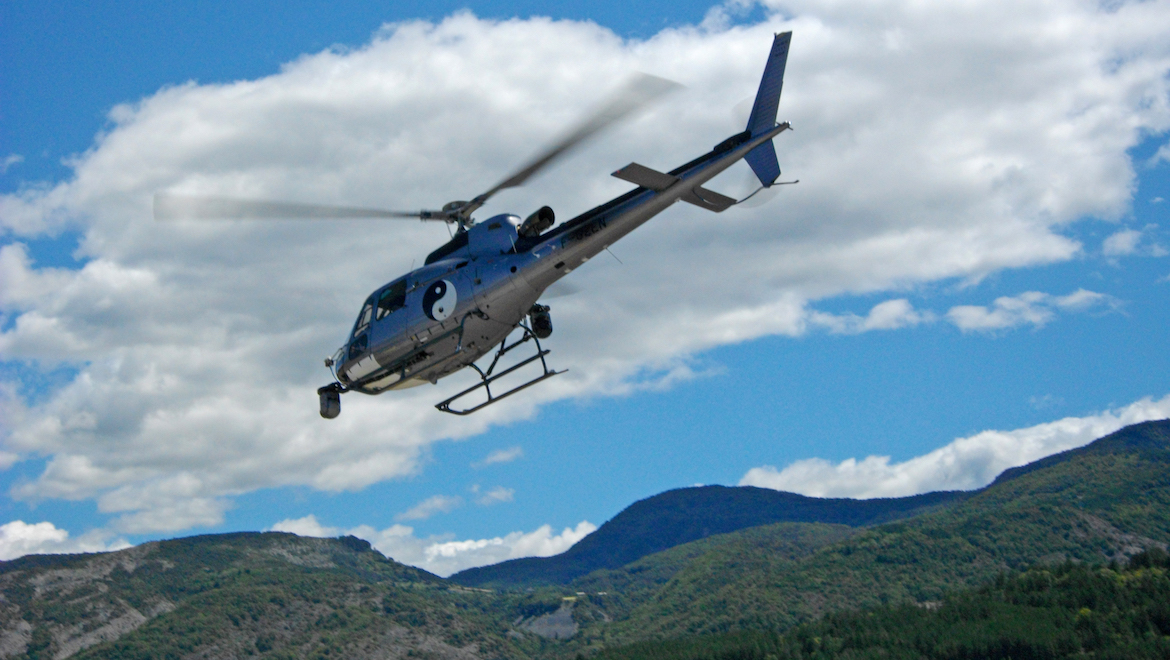
A difficult job
H2’s pilot is Richard Sarrazy, while his cameraman is Bruno Cusa, who in 2011 worked together on the Tour for the fourth time. H1’s pilot is Franck Arrestier and his cameraman Eric Veyssiere, a pairing that has worked together for 17 years. Coordination between pilot and cameraman is essential to ensure smooth imagery and that the camera is aimed in the right direction.
The nature of filming the race means the helicopters fly low, sometimes very low, especially H2 which sometimes flew just a few metres above cornfields, or stays above the race at 100ft AGL. In this scenario the pilot’s job is especially difficult and demanding. He has to adapt his speed to the riders’ speed, fight against downdraughts, and stay in position as long as the sequence lasts, even if there is a strong tailwind, where the helicopter can be susceptible to a main rotor stall, or a crosswind, where the helicopter wants to weathercock.
Much has changed in the 24 years Sarrazy has been a camera pilot at the Tour, the most important being Jean Maurice Ooghe. Sarrazy explains: “Twenty years ago, the director would take what the pilot offered him. Jean Maurice changed all this by stating precisely what he wants.”
Notes Ooghe, “What has also changed is the tools and the training of the pilots. Of course in the beginning, the reconnoitring was very basic, there was only one chopper airborne.”
“One of the problems is to quickly find the race when we have to leave it,” says Sarrazy. “This year for example, the Tourmalet pass was impassable for us owing to clouds. We had to find a way around. Thanks to GPS, we came back at once above the riders on the other side.”
In H2, Sarrazy has supplementary screens, one showing the image filmed by the camera so that he can adjust his trajectory accordingly, a second which shows an electronic version of Ooghe’s roadbook. The pilot can display the itinerary of the stage with all places noted by the director, and with a touch of a finger display the requests for any of these points, such as a helicopter movement. He knows exactly when he is expected to circle around a castle or go and shoot a waterfall. To be on the safe side, Sarrazy enters all these points into a handheld GPS before he takes off.
During the flight, Sarrazy and his cameraman are linked by one-way radio with the director. Unable to reply to any of the director’s instructions or requests by voice, instead, H2 can respond to requests by nodding the camera (left to right for no, up and down for yes) – assuming it is not being used for the live broadcast at that time.
The relays
Each filming helicopter has an associated relay helicopter, which retransmits not just the TV signals from H1 and H2 and the motorbike cameras, but also relays audio feeds, the broadcasts of two radio stations (which have journalists following the race from motorbikes), and “Race Radio” (which the race organisers uses to relay important race information to team managers, medical and emergency services and police, and for the benefit of TV commentators). The relay helicopter also handles radio communications with ATC on behalf of itself and the camera helicopter it is paired with.
As the TV signals from H1 and H2 need to be transmitted line of sight, the transmitter and the relay helicopters need to “see” each other. So the relay helicopters – AS350B2s – typically fly at 3500ft above ground level, and then retransmit the signals up to fixed-wing aircraft which orbit slowly high above the race peloton.
Five fixed-wing aircraft, six when the terrain is mountainous, maintain a vertical separation between each other of 2000ft, typically flying between FL85 and FL195. These aircraft are critical to the live broadcast – without them, there is no live broadcasting – whereas the absence of the relay helicopters simply means a lower quality image – as they forward the signals towards ground stations for onward relay to France Télévision’s control room, either via ground stations or by satellite.
The relay helicopters only operate in visual conditions when they can see the ground. They also have to stay strictly overhead the race, such as when the riders were in a narrow street with high buildings on both sides, so they can relay the pictures from the motorbikes below.
As well as the pilot a technician also flies on the relay helicopter. To help them stay exactly overhead, the relay helicopter pilots have a moving map display showing, thanks to GPS coordinates, the location of the motorbikes and the camera helicopters.
Upper level
Of the fixed-wing relay aircraft – which include one Cessna 404, two PA-34 Senecas, and one Britten-Norman Islander – one travels ahead of the race, following the publicity “caravan” (a parade of over 160 vehicles from race sponsors which hands out free samples to race spectators) an hour and a half before the riders come past.
The other five fixed-wing aircraft fly over the race. Two (one for flat stages) forward the TV signals and another the radio signals for Radio France and Radio Tour. Another two (a King Air 200 and a Cessna 402B) are chartered by a Belgian and a Dutch radio station respectively to forward their own signals.
The fixed-wing aircraft all fly under IFR. If they need to avoid storm activity they can deviate from flying strictly overhead the race, but that can be at the expense of the signal quality.
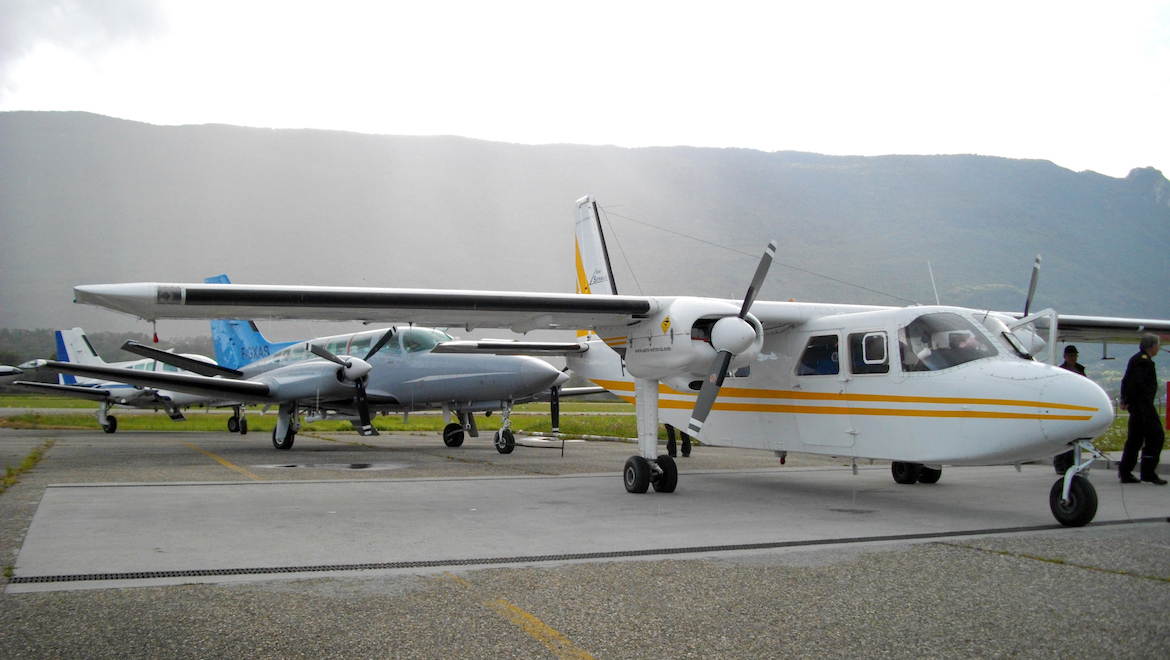
A VIP Experience
As well being central to the live television and radio broadcasts, helicopters are also used to give a lucky few VIPs – usually guests of major sponsors or the race organiser – a bird’s eye view of the race by flying just over the riders.
Each morning two Falcon 900 corporate jets belonging to Dassault Falcon Services depart Paris with some of the VIPs for an airport near the race route – although “near” can be a relative term. For the stage starting in Gap, the corporate jets actually landed in Avignon, more than 100km away from Gap.
The VIP jets are met by five HdF single engine AS350BA Squirrels, which ferry them to a landing area near the “village depart” – the town hosting that day’s race.
The stage itself is divided into five or six sections, 30 to 40km long. For each section, 15 to 25 VIPs are taken by the helicopters to enjoy a 20-minute flight observing the race before landing at the next landing area, where the next group of VIPs (having been driven by road) awaits. Once the new VIPs see the peloton pass, they in turn board the helicopters for their turn to view the race from the air, overflying the race as closely as possible for about 10 minutes.
The VIP helicopters fly between the filming helicopters and their relays, at around 1000ft AGL, and offer the lucky few a breathtaking view of the race action.
At the end of the race the VIP guests are ferried to an airport near the finish town, to be returned to Paris by the corporate jets.
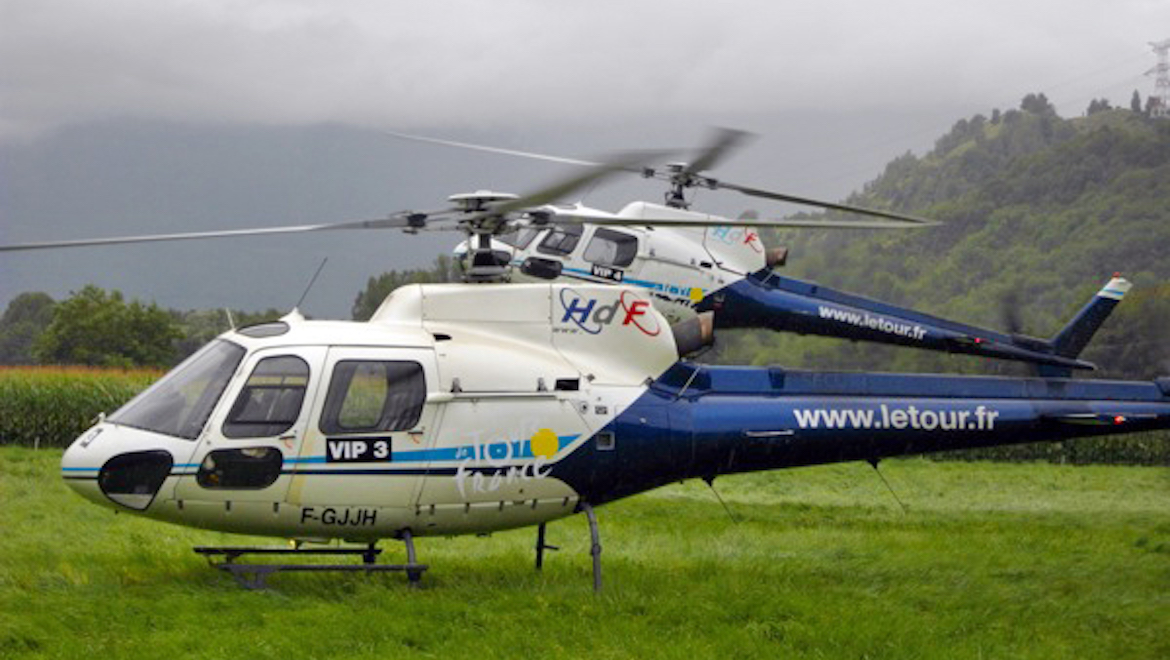
Authorisations
Jean Marc Genechesi, chief of operations for HdF, is in charge of gaining the necessary approvals and dispensations for the race helicopters. HdF does have a standing authorisation (valid for two years) from the French DGAC allowing its helicopters to fly as low as they need outside of built up areas. But that’s not enough for H2. It endlessly enters prohibited, restricted or sensitive areas – prisons, controlled airspace, military airspace, Paris, chemical plants, nature reserves.
Generally for the Tour, all doors open and everyone shows a willingness to grant authorisations and dispensations, but some do refuse. The Ecrins National Park located in the Alps, near the iconic Alpe d’Huez, refuses any overflights.
To overfly cities at low height (500ft) the DGAC requires a twin engine helicopter able to climb on one engine in the event of engine failure. Often that means flying without full tanks to have the necessary available power for the density altitude. Further, the DGAC requires H2 to maintain a minimum speed of 55kt, its best climb rate speed, over which speed it will be much more manoeuvrable and easy to fly should an engine failure occur. Complying with these limitations, H2 may overfly any city at 500ft AGL.

Paris is an exception. The airspace over the French capital is a Prohibited Zone where normally all overflights are prohibited. For the Tour de France’s ceremonial final stage into Paris that finishes with circuits along the Champs Elysées, H2 only can enter the Paris Prohibited Zone. H1 stays out of the prohibited zone limits to shoot beauties, while the relay helicopters land, as the fixed-wing relay aircraft have to fly lower than normal in order not to interfere with traffic operating in and out of Paris’s Roissy Charles de Gaulle and Orly airports.
H2 can overfly Paris at a 1500ft minimum, and is strictly prohibited from deviating from the exact race route.
For each stage of the race the DGAC publishes a supplemental AIP restricting the airspace above the race. With the race overflown by the nine camera and relay helicopters, plus the relay fixed-wing aircraft, a Temporary Restricted Zone is enacted above the race route to keep private spectator aircraft away. But to minimise disruption to other pilots, the stages are split into two zones activated in turn according to the planned schedule of the race.
For example, for the Modane-Alpe d’Huez stage, the 097/11 SUP-AIP published in the beginning of July set two zones, one over the first part of the race, the second over the second half. Each included two vertical sections (one for the helicopters, a second for the fixed wing aircraft) with an airspace block between them to allow for transits. Each part of each zone is activated only when the corresponding aircraft were likely to use them. The Alpe d’Huez aerodrome was also closed from 11am to 7pm, to allow for the dozens of race related helicopter transfers – 25 alone in less than an hour after the race – to transport passengers (including VIPs and even key race riders themselves) to nearby cities to avoid the huge traffic jams on the roads.
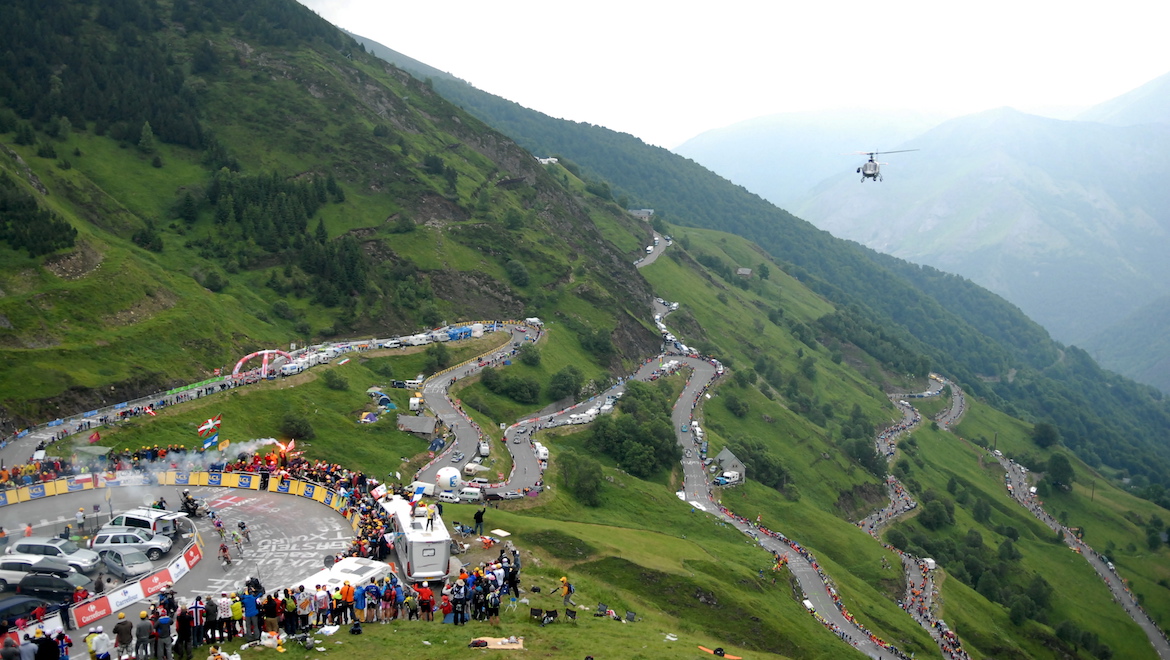
A day on tour
Each day starts with a teleconference attended by the chiefs pilots (TV and radio helicopters, VIP helicopters, relay aircraft), the DGAC and civilian and military air traffic controllers for all airspace which will be used.
Today your correspondent is on hand for the last mountain stage through the French Alps which crosses the Telegraph and the Galibier passes and ends with the legendary Alpe d’Huez climb.
Today H2 has a problem. The live broadcast was due to start at 2:10pm, the start of the race at 2:30pm. Ooghe gives himself until 2:15pm to choose. If H2 is not available by then, he would have H1 takeoff. At the last moment, he is told that H2 had just left. It’s 2:15pm, and H1 therefore stays on the ground for the first part of the broadcast.
The directly talks to the pilot: “H2 you’re on air.” The helicopter is shooting a huge yellow jersey lying on the flank of a mountain near Modane. Ooghe gives him instructions: “Circle around.” Then, when he switches to another image, he lets the pilot know, “Richard, I’ve left you.”
A little later, he gave him new instructions: “You have four minutes to go and shoot the Fort du Sappey.”
During the race, he gives instructions to Bruno, the cameraman: “Zoom back so that we can see the advantage (between breakaway and chasing riders).”
Later, the riders have to enter a tunnel. The director wants to shoot the sequence of the escapees rushing into it from the helicopter. He asks: “Bruno, are we past the entry of the tunnel?” The camera “nods” to say “yes”. He asks again: “Is it still possible (to shoot)?” Answer: “No.”
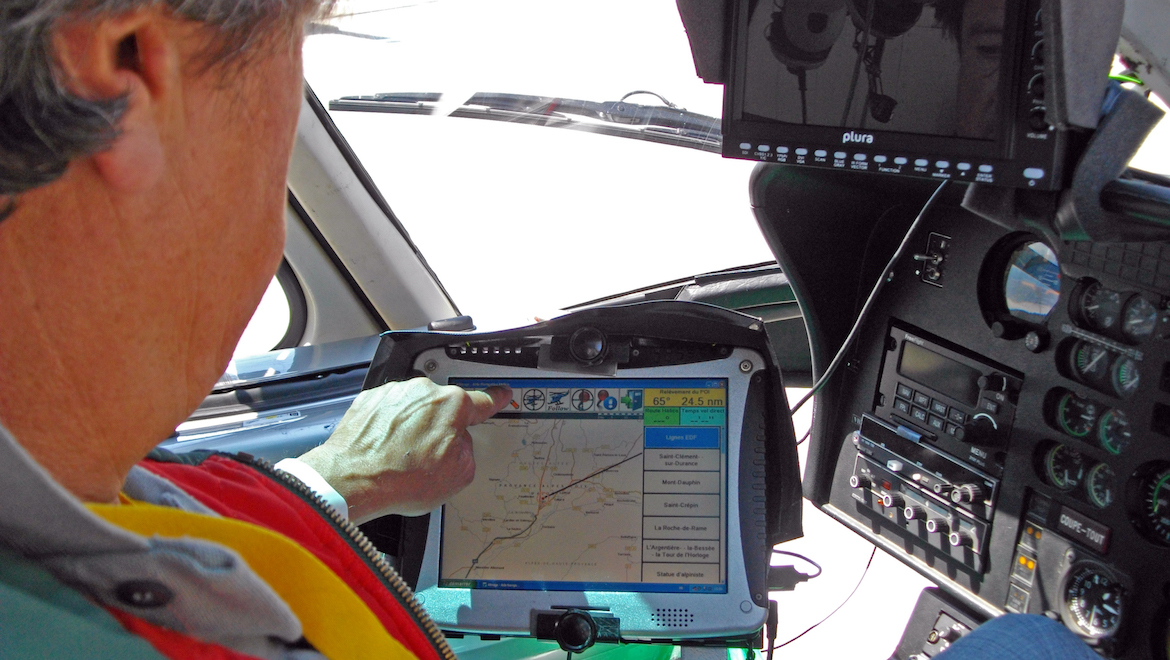
In the control room, an assistant keeps an eye on the road book and tells him which beauties and monuments are next. But today’s critical stage is full of key climbs leaving, as Ooghe had foreseen, only little time for beauties. The race is the hero of the day. He barks orders to the pilot: “Go fetch Evans…”
At 3:30pm, he lets H1 takeoff. He requests a long movement along a crest, both ways, and then the camera zooms on the peloton. A little later, H1 suggests a sequence of horses which had not been planned. He uses it and airs it.
At the Galibier pass, the riders ride through a tunnel. Ooghe had planned to have a helicopter in line with the tunnel to see them backlit and when they exit. That’s exactly what happens and what the race fans see on their TVs.
At 4:20pm, H2 refuels and H1, which had taken off earlier, is on station to shoot the end of the stage. Shortly after 5pm, H2 is supposed to shoot the famous road to Alpe d’Huez with its renowned hairpin bends from overhead, just before the first riders start to climb. But, according to the news Ooghe has in the control room, H2 has not yet taken off again.
In fact, H2 is airborne, but its signals are not being transmitted. The transmission problem is fixed at 5:15, too late for the sequence Ooghe had planned. Meanwhile, H1 had focused on the race. H2 must therefore climb very high above the Alpe and zoom as much as possible to film Spanish rider (and former Tour winner) Alberto Contador, then zoom back to show the dreaded hairpin bends and, eventually, the Alpe d’Huez resort.
Concerned for a moment, Ooghe asks a technician who has radio contact with the helicopters: “Gerard, find out whether the helicopters are not too close.” They’re both overhead groups of riders which, because of the hairpin bends, are in close proximity to each other.
The winner of the stage (Pierre Rolland) finishes at 5:50pm. At 6:05pm, Ooghe lets H1 land, whereas H2 keeps shooting beauties for the international signal. The last riders finish at 6:15 and Ooghe releases H2 at 6:20pm, by which stage the airspace above the race has been reopened for five minutes.
And so another day of busy action in which aviation plays such a critical role in bringing the Tour de France to the world comes to a close.
VIDEO: The conclusion of Stage 18 of the 2011 Tour de France from the xbikeX1 YouTube channel.
This story first appeared in the October 2011 edition of Australian Aviation.













